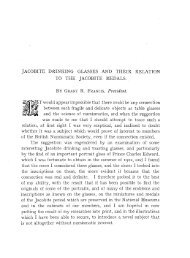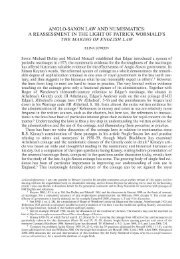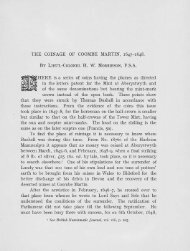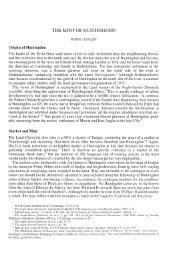the chemical compositions of nineteenth- century copper-base ...
the chemical compositions of nineteenth- century copper-base ...
the chemical compositions of nineteenth- century copper-base ...
Create successful ePaper yourself
Turn your PDF publications into a flip-book with our unique Google optimized e-Paper software.
THE CHEMICAL COMPOSITIONS OF NINETEENTH-<br />
CENTURY COPPER-BASE ENGLISH JETONS<br />
M. B. MITCHINER, C. MORTIMER and A. M. POLLARD<br />
THIS paper, in which jetons are defined in <strong>the</strong> general Continental sense to mean<br />
die-stamped small metal discs without intrinsic monetary value, spans a period <strong>of</strong><br />
fundamental change in <strong>the</strong> English brass-making industry. Traditional calamine brass gave<br />
way to spelter brass and <strong>the</strong> Birmingham brass houses became pre-eminent. These changes<br />
are reflected by <strong>the</strong> jetons <strong>the</strong>mselves which are best studied in three roughly equal<br />
periods. All specimens were analysed by <strong>the</strong> X-ray fluorescence technique using <strong>the</strong><br />
methods and standards described previously. 1<br />
From c. 1790 to 1830<br />
Three main alloys were popular during this period. Traditional calamine brass with a zinc<br />
content <strong>of</strong> 20 to 25 per cent was initially <strong>the</strong> preferred alloy, but this was to receive<br />
competition from brass made by Champion's granulated <strong>copper</strong> process with its higher zinc<br />
content <strong>of</strong> 30 to 33 per cent. Alongside <strong>the</strong>se brasses were <strong>the</strong> gilding metals which had low<br />
zinc contents in <strong>the</strong> general range <strong>of</strong> 4 to 7 per cent and were normally used for making<br />
planchets that were subsequently to be silver plated.<br />
Thomas Halliday: floruit 1797-1845/49 2<br />
BIRMINGHAM FIRMS<br />
School counters <strong>of</strong> Princess Charlotte type probably struck shortly after her death in 1817.<br />
1. Obv. Diad. bust left: signed below - H<br />
H.R.H. THE.PRINCESS.CHARLOTTE - below: BORN.JAN.7.1796.D1ED.NOV.6.1817<br />
Rev. In a frame within ornamental cartouche: 5 INTEGERS<br />
(Hawkins 1975 3 no. 3005)<br />
2. Obv. Diad. bust left: signed below - H<br />
H. R. H .THE. PRINCESS. CHARLOTTE<br />
Rev. Around rose: ONE.INTEGER: broad floral border<br />
(Hawkins 1975 no. 3004)<br />
1 M. Robinson and A. M. Pollard, 'Analysis <strong>of</strong> Burmese<br />
coins by X-ray fluorescence', NCirc (1983), 263-6 and 293-6;<br />
M. B. Mitchiner and A. Skinner, 'English tokens: c. 1200 to<br />
1425', BNJ 53 (1983), 29-77; M. B. Mitchiner and A.<br />
Skinner, 'Contemporary forgeries <strong>of</strong> English silver coins and<br />
<strong>the</strong>ir <strong>chemical</strong> <strong>compositions</strong>: Henry III to William III', NC<br />
(1985), 209-36; M. B. Mitchiner, C. Mortimer and A. M.<br />
Pollard, 'The <strong>chemical</strong> <strong>compositions</strong> <strong>of</strong> English seventeenth<strong>century</strong><br />
<strong>base</strong> metal coins and tokens', BNJ 55 (1985), 144-63<br />
and <strong>the</strong> references cited <strong>the</strong>rein.<br />
2 R. N. P. Hawkins, 'Dictionary <strong>of</strong> Birmingham makers<br />
<strong>of</strong> metallic tickets, checks and counters during <strong>the</strong> middle<br />
and later part <strong>of</strong> <strong>the</strong> 19th <strong>century</strong>', SCMB (1960), 142 and<br />
180. R. N. P. Hawkins published a series <strong>of</strong> articles on <strong>the</strong><br />
makers <strong>of</strong> metallic tickets in this journal from 1960 until<br />
1976. Subsequent references to this series are cited in <strong>the</strong><br />
form Hawkins SCMB - plus date and page.<br />
- 1 R. N. P. Hawkins, 'School counters for marks <strong>of</strong> merit',<br />
in Four studies <strong>of</strong> British metallic tickets and commercial<br />
checks <strong>of</strong> <strong>the</strong> 19th-20th centuries, BANS Doris Stockwell<br />
Memorial Papers no. 2 (1975). pp. 1-31.
78 CHEMICAL COMPOSITION OF NINETEENTH-CENTURY JETONS<br />
Kettle firm: floruit 1792-1830<br />
Signed jetons and medalets span this period and are accompanied by a much larger number <strong>of</strong> closely related<br />
unsigned pieces, probably mainly produced by <strong>the</strong> same firm. 4<br />
'Napoleonic series <strong>of</strong> 1814—1815': a close-knit die-linked series. 5<br />
3. Obv. Napoleon seated backwards on a cow being led by walking horned devil who pulls a halter around<br />
Napoleon's neck: INSEPERABLE.FRIENDS - in ex: TO.ELBA<br />
Rev. around top: WE.CONQUER.TO.SET.FREE<br />
field: EMP./OF.RUSSIA/K.OF.PRUSSIA/MARQUIS/WELLINGTON/PRINCE/<br />
SCHWARTZEN- /BERG<br />
bottom: MARCH.31.1814<br />
(Ano<strong>the</strong>r jeton from <strong>the</strong> same obverse die has on <strong>the</strong> reverse <strong>the</strong> inscription in twelve lines 'The liberties<br />
<strong>of</strong> Europe rest by <strong>the</strong> united efforts <strong>of</strong> England and her august allies. The preliminaries <strong>of</strong> peace signed<br />
May 30, 1814)<br />
4. Obv. Bare head left: ALEXANDER.EMP.OF.ALL.THE.RUSSIAS<br />
Rev. same die as previous jeton.<br />
5. Obv. Armed horseman galloping left: CROWN.PRINCE.OF.ORANGE - HOLLANDS.GLORY<br />
Rev. In wreath: WATERLOO/JUNE. 18.1815<br />
(Batty 1878, p. 508, no. 4964h)<br />
'Monarchs and famous persons series <strong>of</strong> 1820-1830': an extensive series in which <strong>the</strong> present pieces probably<br />
emanate from <strong>the</strong> Kettle workshop. Ano<strong>the</strong>r known manufacturer <strong>of</strong> related jetons was Ingram.<br />
6. Obv. King's bust left: H.M.G.M.KING.GEORGE.Ill<br />
Rev. BORN.JUNE 4.1738.CROWNED.OCTR.25.1760.DIED.JANY.29.1820.IN.THE.60.YEAR.<br />
OF.HIS.REIGN. AND.IN.THE.82.YEAR.OF.HIS. AGE.<br />
(Batty 1878, p. 421, nos. 4137a-f: <strong>the</strong> same incorrect reverse occurs on a related issues signed KETTLEauthor<br />
and Batty 4137s-t. George III acceeded when George II died on 25 Oct. 1760, but he was<br />
crowned on 22 Sept. 1761)<br />
7. Obv. Bare headed bust left: FREDERICK.DUKE.OF.YORK<br />
Rev. Wrea<strong>the</strong>d funerary urn on stand, inscribed: DIED/JANY.5th./1827<br />
around: BORN.AUGUST.16.1763 - THE.SOLDIERS.FRIEND<br />
(Batty 1878, p. 520 no. 5069c)<br />
8. Obv. King's bare head left: GEORGE.IV.KING.OF.GREAT.BRITAIN<br />
Rev. Laureate funerary urn on stand, inscribed: BORN.1762 / DIED.1830<br />
above: BELOVED.&.LAMENTED<br />
9. Obv. as previous jeton, different die<br />
Rev. In wreath: BORN/1762/DIED/JUNE 26/1830<br />
(Batty 1878, p. 436 no. 4236o)<br />
Thomas Wells Ingram: floruit 1806-38 6<br />
His work includes a number <strong>of</strong> signed card counters closely related to <strong>the</strong> present unsigned specimen depicting<br />
Edmond Hoyle, <strong>the</strong> 'fa<strong>the</strong>r <strong>of</strong> whist'. It was probably struck about 1830.<br />
10. Obv. Man seated left playing cards, with ace <strong>of</strong> spades in raised hand: ano<strong>the</strong>r ace on table: above:<br />
HOYLE<br />
Rev. In wreath: KEEP / YOUR / TEMPER<br />
Coin forgery<br />
This class <strong>of</strong> plated forgery (normally shillings) is commonly encountered and probably emanates from<br />
Birmingham. A recent hoard has been published by Hawkins. 7<br />
11. George III halfcrown dated 1819<br />
(Mitchiner and Skinner 1985, 8 no. 48)<br />
" For example, R. N. P. Hawkins, 'Minor products <strong>of</strong><br />
British <strong>nineteenth</strong>- <strong>century</strong> diesinking', BNJ (1960), 174-89,<br />
appendix 1: also numerous examples described by D.T.<br />
Batty, Batty's descriptive catalogue <strong>of</strong> <strong>the</strong> <strong>copper</strong> coinage <strong>of</strong><br />
Great Britain, Ireland, British Isles and colonies, local and<br />
private tokens, jettons etc, (Manchester, 1868-98).<br />
5 In addition to fur<strong>the</strong>r unpublished issues see also Batty<br />
(1877, p. 388 no. 3944) and, for mainly Continental pieces,<br />
R. Chalon, 'Numismatique de Waterloo', RBN (1878),<br />
421-43.<br />
"Hawkins, BNJ (1960), 177; SCMB (1960), 182 and<br />
(1970), 44; also Batty 1877, p. 399 no. 4002d.<br />
7 R. N. P. Hawkins, 'A hoard <strong>of</strong> uncirculated forged<br />
George III shillings', SCMB (1985), 237-8.<br />
8 M. B. Mitchiner and A. Skinner, 'Contemporary forgeries<br />
<strong>of</strong> English silver coins and <strong>the</strong>ir <strong>chemical</strong> <strong>compositions</strong>:<br />
Henry III to William III', NC (1985), 209-36.
Wyon: issued c.1790<br />
CHEMICAL COMPOSITION OF NINETEENTH-CENTURY JETONS<br />
LONDON FIRMS<br />
12. Obv. Busts <strong>of</strong> king and queen right: GEORGIUS.III.ET.CHARLOTTE.REX.ET.REG.<br />
Rev. Pair <strong>of</strong> outline hearts with crown above: PATRONS.OF.VIRTUE<br />
(Brown, 9 340; Fearon 1984, 10 241.1; Batty 1884, p. 677 no. 2052)<br />
Closely related jetons were signed by Wyon and dated 1790.<br />
Anonymous: an East India Company recruiting ticket issued circa 1835<br />
13. Obv. Armed mounted dragoon brandishing sword, galloping right: HORSE. ARTILLERY<br />
Rev. Field: APPLY/AT.No.35/SOHO.SQUARE/LONDON<br />
around: WANTED .FOR.THE. EAST. INDIES<br />
(Bell 1975,p. 5; Pridmore 1975, 12 p. 270 no. 398) See also Mitchiner 1979 13 no. 2106.<br />
Weight 14 Cu Zn Sn Pb Ag Ni As Sb Fe Ref.<br />
BIRMINGHAM<br />
1. Halliday c. 1817/18 13.20 77.2 22.0 - 0.18 0.08 - 0.35 _ - 713<br />
2. Halliday c. 1817/18 6.36 76.6 22.1 0.24 0.79 0.07 - 0.49 0.17 0.20 714<br />
3. Kettle<br />
(die-link 4)<br />
1814<br />
silvered surface<br />
4.40 93.9 4.7 0.29<br />
0.39<br />
0.40 0.08<br />
0.46<br />
- 0.44 - 0.14 319<br />
4. Kettle (die-link 3) 1814 5.05 78.1 20.7 - 0.61 - — 0.42 _ 0.08 460<br />
5. Kettle (silvered) 1815 3.95 94.0 5.0 - 0.30 0.28 - tr - 0.09 461<br />
6. Kettle 1820 3.85 73.8 25.1 - 0.46 - - 0.51 — 0.11 544<br />
7. Kettle 1827 5.48 73.1 26.4 - 0.13 - - tr — 0.10 545<br />
8. Kettle<br />
9. Kettle<br />
1830<br />
1830<br />
5.45<br />
5.70<br />
69.1 30.4<br />
67.0 32.2<br />
-<br />
-<br />
0.09 0.13<br />
0.26 0.09<br />
-<br />
-<br />
-<br />
0.37<br />
-<br />
_<br />
0.15<br />
0.07<br />
546<br />
547<br />
10. Ingram firm c. 1830 4.15 92.4 6.6 - 0.41 - tr 0.21 0.11 0.09 323<br />
11. Coin forgery dated 1819 12.44 90.8 7.1 0.30 0.50 - - 0.40 _ 0.50 48<br />
silvered surface 3.4 (trace : Mercury)<br />
LONDON<br />
12. Wyon c. 1790 2.60 78.5 20.1 0.43 0.23 - - 0.52 0.18 - 712<br />
13. East India<br />
Company<br />
c. 1835 76.2 22.5<br />
_<br />
0.53 0.09 — 0.27 0.13 0.11 X48<br />
Traditional calamine brass<br />
Brass continued to be made in England by <strong>the</strong> traditional calamine process with zinc<br />
content in <strong>the</strong> range 20 to 25 per cent until well into <strong>the</strong> <strong>nineteenth</strong> <strong>century</strong>. Among items<br />
emanating from <strong>of</strong>ficial numismatic circles one may make mention <strong>of</strong> a Royal Mint<br />
sovereign weight dated 1821 with a zinc content <strong>of</strong> 20.4 per cent. 15 This quality <strong>of</strong> brass had<br />
a pedigree extending back through Nuremberg jetons, 16 English seventeenth-<strong>century</strong><br />
9 L. A. Brown, British Historical Medals, 1760-1960. Vol.<br />
1, 1760-1837 (London 1980).<br />
10 D. Fearon, Catalogue <strong>of</strong> British Commemorative<br />
Medals: 1558 to <strong>the</strong> present day (London, 1984).<br />
11 R. C. Bell, Un<strong>of</strong>ficial farthings, 1820-1870 (London,<br />
1975).<br />
12 F. Pridmore, The Coins <strong>of</strong> <strong>the</strong> British Commonwealth <strong>of</strong><br />
Nations to <strong>the</strong> end <strong>of</strong> <strong>the</strong> reign <strong>of</strong> George VI, 1952. Part 4.<br />
India: vol. 1. The East India Company Presidency series,<br />
c. 1642-1835 (London, 1975).<br />
13 M. B. Mitchiner, Oriental coins and <strong>the</strong>ir values: III.<br />
Non-Islamic States and Western Colonies (London, 1979).<br />
14 Weights are cited in grammes. Standard <strong>chemical</strong> sym-<br />
bols are used for metals: Cu, <strong>copper</strong>: Zn, zinc: Sn, tin: Pb,<br />
lead: Ag, silver: Ni, nickel: As, arsenic: Sb, antimony: Fe,<br />
iron.<br />
15 M. B. Mitchiner, C. Mortimer and A. M. Pollard, 'The<br />
<strong>chemical</strong> <strong>compositions</strong> <strong>of</strong> English seventeenth-<strong>century</strong> <strong>base</strong><br />
metal coins and tokens', BNJ 55 (1985), see no. 75. For<br />
production data relating to early Tintern brass see M. B.<br />
Donald, Elizabethan Monopolies: <strong>the</strong> history <strong>of</strong> <strong>the</strong> Company<br />
<strong>of</strong> Mineral and Battery Works, 1568-1604 (London,<br />
1961).<br />
16 M. B. Mitchiner, C. Mortimer and A. M. Pollard,<br />
'Nuremberg and its jetons, circa 1475 to 1888: <strong>chemical</strong><br />
<strong>compositions</strong> <strong>of</strong> <strong>the</strong> alloys', NC (1987), 114-55.
80 CHEMICAL COMPOSITION OF NINETEENTH-CENTURY JETONS<br />
tokens and Charles I's farthings (brass wedges), 17 jetons <strong>of</strong> <strong>the</strong> Low Countries 18 and<br />
medieval pilgrim badges 19 to sundry Roman coins and badges. 20<br />
The seven calamine brass jetons (medalets) in this section are among <strong>the</strong> latest English<br />
artefacts to have been made in traditional calamine brass. With <strong>the</strong> fall in zinc prices<br />
consequent upon increased exploitation <strong>of</strong> zinc ores and more active refining 21 during <strong>the</strong><br />
early <strong>nineteenth</strong> <strong>century</strong> spelter brass (i.e. metallic zinc directly alloyed with <strong>copper</strong>)<br />
undercut <strong>the</strong> price <strong>of</strong> calamine brass and <strong>the</strong> calamine process soon became obsolete.<br />
Copper: 77.2,76.6,78.1,73.8,73.1,78.5,76.2 mean: 76.2 per cent (SD.2.1)<br />
per cent<br />
Zinc: 22.0,22.1,20.7,25.1,26.4,20.1,22.5 mean: 22.7 per cent (SD.2.3)<br />
per cent<br />
(The sum <strong>of</strong> <strong>copper</strong> plus zinc is close to 99 per cent in all cases.)<br />
Brass made by <strong>the</strong> granulated <strong>copper</strong> process<br />
Although <strong>the</strong> granulated <strong>copper</strong> process for raising <strong>the</strong> zinc content <strong>of</strong> calamine brass had<br />
been used on <strong>the</strong> Continent since 1560, 22 <strong>the</strong> credit for using this process on a commercial<br />
scale in England belongs to Nehemiah Champion 23 who obtained a patent in 1723. Using<br />
this process <strong>the</strong> zinc content <strong>of</strong> <strong>the</strong> resulting brass can be raised to a maximum value <strong>of</strong> 34<br />
per cent. 24<br />
Only two <strong>of</strong> <strong>the</strong> present specimens belong in this category:<br />
Copper: 69.1, 67.0 per cent mean: 68.1 per cent (SD.1.5)<br />
Zinc: 30.4, 32.2 per cent mean: 31.3 per cent (SD.1.3)<br />
Gilding brasses<br />
The name gilding brass (gilding metal) is a general term for a group <strong>of</strong> low-zinc brasses 25<br />
that have been popular since <strong>the</strong> eighteenth <strong>century</strong>. In earlier times low-zinc brasses,<br />
more <strong>of</strong>ten known by <strong>the</strong> name latten, 26 had been made by alloying down calamine brass.<br />
Due to volatalisation <strong>the</strong> zinc content was difficult to control and somewhat variable. 27 The<br />
gilding metals were made by directly alloying metallic zinc with <strong>copper</strong> and had a more<br />
17<br />
Mitchiner, Mortimer and Pollard, 'English seventeenth<br />
<strong>century</strong> <strong>base</strong> metal coins and tokens'.<br />
18<br />
M. B. Mitchiner, C. Mortimer and A. M. Pollard, 'The<br />
alloys <strong>of</strong> Continental <strong>copper</strong>-<strong>base</strong> jetons (Nuremberg and<br />
medieval France excepted)'. To be published.<br />
19<br />
M. B. Mitchiner, Medieval Pilgrim and Secular Badges<br />
(London, 1986).<br />
20<br />
Badges to be published. For coins see P. T. Craddock,<br />
'The composition <strong>of</strong> <strong>copper</strong> alloys used by <strong>the</strong> Greek,<br />
Roman and Etruscan civilisations; 3. The origins and early<br />
use <strong>of</strong> brass', Journal <strong>of</strong> Archaeological Sciences 5 (1978),<br />
1-16: P. T. Craddock, A. M. Burnett and K. Preston,<br />
'Hellenistic <strong>copper</strong> <strong>base</strong> coinage and <strong>the</strong> origins <strong>of</strong> brass', in<br />
Scientific Studies in Numismatics, edited by W. A. Oddy.<br />
BM. Occasional paper no. 18 (1980): E. R. Caley, Orichalcum<br />
and related ancient alloys (NNM. no. 150 <strong>of</strong> <strong>the</strong> ANS.<br />
New York, 1964): C. F. Carter and C. E. King, 'Chemical<br />
<strong>compositions</strong> <strong>of</strong> <strong>copper</strong>-<strong>base</strong>d Roman coins. IV. Tiberius to<br />
Nero, AD 34-66', in Metallurgy in Numismatics, I (RNS.<br />
London, 1980), 157-67.<br />
21<br />
Factories were opened in Carinthia (1799), Ruhberg<br />
(1799/1800) and Liege (1809). English import tariffs were<br />
lowered in 1830. See T. E. Lones, Zinc and its alloys<br />
(London, 1919): H. Hamiton, The English brass and <strong>copper</strong><br />
industries to 1800, 2nd edn, (London, 1967).<br />
22<br />
This date is <strong>base</strong>d on scientific instruments and jetons<br />
analysed by us at <strong>the</strong> Research Laboratory for Archaeology<br />
in Oxford. See A. M. Pollard, 'An investigation <strong>of</strong> <strong>the</strong> brass<br />
used in mediaeval and later scientific instruments', paper<br />
presented to UKIC meeting 'The preservation <strong>of</strong> historical<br />
scientific material', Geological Museum, 14 Nov. 1983 (proceedings<br />
to be published): Mitchiner, Mortimer and Pollard,<br />
'Continental jetons'. See also H. K. Cameron, 'Technical<br />
aspects <strong>of</strong> mediaeval monumental brasses', Archaeological<br />
Journal 131 (1974), 215-37.<br />
23 Patent no. 454. See Hamilton, English brass and <strong>copper</strong><br />
industries to 1800: also J. Day, Bristol Brass: a History <strong>of</strong> <strong>the</strong><br />
Industry (Newton Abbot, 1973).<br />
24 See Craddock, Origins and early use <strong>of</strong> brass.<br />
25 For <strong>the</strong> physico-<strong>chemical</strong> properties <strong>of</strong> gilding brasses<br />
see E. G. West, Copper and its alloys (Chichester, 1982).<br />
26 As written, for instance, in <strong>the</strong> inscriptions <strong>of</strong> many<br />
medieval French jetons. Discussed in M. B. Mitchiner and<br />
A. M. Pollard, 'Reckoning counters: patterns <strong>of</strong> evolution<br />
in <strong>the</strong>ir <strong>chemical</strong> composition', British Museum and Royal<br />
Numismatic Society symposium on <strong>the</strong> use <strong>of</strong> scientific<br />
techniques for studying <strong>the</strong> coinage <strong>of</strong> Europe and <strong>the</strong><br />
Mediterranean World, AD 500-1500, British Museum,<br />
London 6-7 April 1984 (proceedings to be published). See<br />
also Mitchiner, Mortimer and Pollard, 'Continental jetons'.<br />
27 See analytical results in <strong>the</strong> papers just cited.
CHEMICAL COMPOSITION OF NINETEENTH-CENTURY JETONS<br />
reproducible composition. Tombac and pinchbeck, were two early European forms 28 and<br />
paktong was a much earlier Chinese version. Metallic zinc had been imported from <strong>the</strong><br />
Orient by <strong>the</strong> English and Dutch East India Companies since <strong>the</strong> seventeenth <strong>century</strong> 29<br />
and <strong>the</strong> metal was later refined in Europe. In England William Champion obtained his<br />
patent for refining zinc in 1738, 30 but <strong>the</strong> metal remained expensive and could only be used<br />
commercially during ensuing decades for such low-zinc alloys as gilding metals. In 1781<br />
Emerson took out a patent 31 for making higher zinc spelter brass by direct mixing.<br />
Although in 1786 Watson praised his alloy as '<strong>the</strong> purest and finest brasses in <strong>the</strong> world', it<br />
proved too expensive and Emerson was bankrupted in 1803.<br />
Three <strong>of</strong> <strong>the</strong> present jetons, plus <strong>the</strong> coin forgery, are made <strong>of</strong> gilding metal and three <strong>of</strong><br />
<strong>the</strong>se are silver-plated. Several fur<strong>the</strong>r jetons in <strong>the</strong> Kettle series have <strong>the</strong> appearance <strong>of</strong><br />
gilding metal and are also silvered. 32 The composition is:<br />
Copper: 93.9, 94.0, 92.4, 90.8 per cent mean: 92.8 per cent (SD. 1.5)<br />
Zinc: 4.7, 5.0, 6.6, 7.1 per cent mean: 5.9 per cent (SD. 1.2)<br />
Plating: Ag -I- Sn (not analysed) (not plated) Ag,tr.Hg<br />
The plating suggests that <strong>the</strong> Kettle firm was using a tin-containing silver wash. A similar<br />
situation has been observed in <strong>the</strong> case <strong>of</strong> some Nuremberg jetons 33 (o<strong>the</strong>r, generally<br />
earlier, jetons only had a tin wash 34 ). The coin forgery suggests silver plating by <strong>the</strong><br />
mercury amalgam technique, a process also suggested in <strong>the</strong> case <strong>of</strong> some medieval English<br />
coin forgeries and some o<strong>the</strong>r Nuremberg jetons. 36<br />
From c.1830 to 1870<br />
The increased scale <strong>of</strong> European zinc production in <strong>the</strong> early <strong>nineteenth</strong> <strong>century</strong>, 37<br />
combined with <strong>the</strong> easing <strong>of</strong> English import tariffs in 1830, made metallic zinc both cheaper<br />
and more plentiful. This turned <strong>the</strong> tide in favour <strong>of</strong> spelter brass and <strong>the</strong> phasing out <strong>of</strong><br />
<strong>the</strong> calamine process. Cheadle (c. 1830) and Bristol (c. 1840) converted to <strong>the</strong> spelter<br />
process. The last recorded use <strong>of</strong> a calamine furnace in South Wales was in 185 8 38 and in<br />
Birmingham <strong>the</strong> last calamine brass-house closed in 1866. 39<br />
In <strong>the</strong> field <strong>of</strong> English jetons and related cheap small <strong>copper</strong>-<strong>base</strong> artefacts <strong>the</strong> period <strong>of</strong><br />
transition from calamine brass to spelter brass was marked by a distinct preference for <strong>the</strong><br />
use <strong>of</strong> low-zinc recipes. This does not imply any decline in <strong>the</strong> use <strong>of</strong> high-zinc alloys for<br />
o<strong>the</strong>r purposes; but it does suggest that during this transitional phase considerations <strong>of</strong> cost<br />
may have made <strong>the</strong> low-zinc brasses a better economic proposition in <strong>the</strong> field <strong>of</strong> cheap<br />
stamped metal discs. Be that as it may, <strong>the</strong>re can be no doubt that by around 1870 <strong>the</strong> cost<br />
<strong>of</strong> spelter brass had fallen low enough to permit <strong>the</strong> mass production <strong>of</strong> 'spade guinea'<br />
jetons and related artefacts at little expense. These will be considered in <strong>the</strong> next section.<br />
28<br />
Described in 1786 by R. Watson, Chemical essays IV<br />
(London, 1786).<br />
29<br />
High zinc brasses which have a zinc content greater than<br />
34 per cent attest <strong>the</strong> use <strong>of</strong> at least some metallic zinc in <strong>the</strong><br />
brass-making process. This was first documented by Glauber<br />
in De Prosperitate Germanias (Amsterdam, 1656). Our<br />
analytical results attest <strong>the</strong> process from 1650 onwards, and<br />
have been discussed in Mitchiner, Mortimer and Pollard,<br />
'English seventeenth-<strong>century</strong> <strong>base</strong> metal coins and tokens'.<br />
30<br />
Patent no. 564. R.F. Tylecote, A History <strong>of</strong> Metallurgy<br />
(London, 1976), p. 132: also J. Day, Bristol Brass.<br />
31<br />
Patent no. 1297.<br />
32<br />
Author's collection (MBM): not analysed: some signed<br />
by Kettle.<br />
33 Mitchiner, Mortimer and Pollard, 'Nuremberg jetons'.<br />
34 M. B. Mitchiner and A. M. Pollard, 'Tin-plated 16th<br />
<strong>century</strong> Nuremberg reckoning counters from <strong>the</strong> River<br />
Thames', NCirc (1983), 152-53.<br />
35 Mitchiner and Skinner, 'Contemporary forgeries <strong>of</strong><br />
English silver coins'.<br />
36 Mitchiner, Mortimer and Pollard, 'Nuremberg jctons'.<br />
37 Noted above: see also Lones (1919).<br />
38 Hamilton, English brass and <strong>copper</strong> industries to 1800.<br />
39 W. C. Aitken, 'Brass and brass manufacture' in The<br />
resources, products and industrial history <strong>of</strong> Birmingham and<br />
<strong>the</strong> Midland hardware district, edited by S. Timmins<br />
(London, 1866), pp. 225-381.
82 CHEMICAL COMPOSITION OF NINETEENTH-CENTURY JETONS<br />
Coronation medalets<br />
BIRMINGHAM FIRMS<br />
These may have been made by ei<strong>the</strong>r <strong>the</strong> Kettle or <strong>the</strong> Ingram firm, both <strong>of</strong> which had issued related signed<br />
pieces during <strong>the</strong> 1820s<br />
14. Obv. King's bare head right: WILLI AM. I V.KING. OF. GREAT. BRITAIN,<br />
in small letters above head: CROWNED.SEP.8.1831<br />
Rev. Queen's bust right: HER.MOST.GRACIOUS.MAJESTY.QUEEN.ADELAIDE<br />
(Batty 1878, p. 516 no. 5053h)<br />
15. Obv. Queen's diad. bust left: HER.MOST.GRACIOUS.MAJESTY.VICTORIA<br />
Rev. Crown: above: BORN.MAY.24.1819<br />
below: CROWNED / JUNE.28.1838<br />
(Batty 1878, p. 501 no. 4911y)<br />
Card counters<br />
16. Obv. Garter arms with half length lion and unicorn supporters: slightly faulty inscriptions:<br />
HONI.SOIT.QUI.MAL.P.Y and DIEU.ET.MON.DROT<br />
Rev. Field: KEEP. YOUR / TEMPER<br />
around: BE.MODERATE.IN.YOUR.STAKES<br />
Issued during <strong>the</strong> 1840s or <strong>the</strong> early 1850s. For allied issues see Batty 1884 (p. 671 no. 1964)<br />
dated 1847, and Batty 1884 (p. 671 no. 1967) dated 1859: also Hawkins BNJ (1960), 178, for a<br />
note written in 1851, and Hawkins NC (1959) no. 59, dated 1846; Hawkins SCMB (1960), 95,<br />
dated 1848 and 1853.<br />
17. Obv. Victoria's young head left: VICTORIA.REGINA<br />
Rev. Fan <strong>of</strong> three playing cards: Jack <strong>of</strong> diamonds accosted by six <strong>of</strong> spades and five <strong>of</strong> clubs.<br />
(Batty 1884, p. 670 no. 1949: and see also Hawkins NC (1959), no. 5.)<br />
18. Obv. Victoria's young head left: VICTORIA.QUEEN.OF.GREAT.BRITAIN<br />
Rev. same punch for <strong>the</strong> cards design, but struck on a smaller flan<br />
(Batty 1884, p. 670 no. 1953)<br />
These two issues can be dated to <strong>the</strong> 1850s, partly by succession from <strong>the</strong> 'Keep your temper'<br />
issues, and partly by comparison with related (and sometimes obverse die-linked) 'To<br />
Hanover' counters.<br />
'To Hanover' counters: issued 1837 to c.1883<br />
19. Obv. Victoria's young head left: VICTORIA.REGINA<br />
Rev. Duke <strong>of</strong> Cumberland on horseback, with three-headed dragon below:<br />
above: TO.HANOVER - in ex. 1837 (traditional date)<br />
(cf. Hawkins, NC (1959), nos 1-4; issued 1837 - c. 1840s)<br />
20. standard designs: H.M.G.M.QUEEN.VICTORIA: dated in reverse exergue 1854<br />
(Not listed by Hawkins: but cf. no. 24 dated 1859)<br />
21. standard designs: VICTORIA.QUEEN.OF.GREAT.BRIT: dated below head 1862<br />
(Hawkins, NC (1959), no. 51)<br />
22. standard designs: H.M.G.M.QUEEN.VICTORIA: dated below head 1867<br />
(cf. Hawkins, NC (1959), nos 63-64)<br />
23. same issue<br />
Prince <strong>of</strong> Wales half sovereign counters: issued 1842 to 1870s<br />
24. Obv. Victoria's young head left: VICTORIA.QUEEN.OF.GREAT.BRIT:<br />
Rev: Three plumes in crown: all in garter inscribed: HONI.SOIT.QUI.MAL.Y.PENSE<br />
(Magnay 1980 40 type 1: issued 1842-late 1840s)<br />
25. Obv. Victoria's young head left: VICTORIA.QUEEN.OF.GREAT.BRITAIN: dated below<br />
head 1850<br />
Rev. Three plumes in crown: garter not inscribed: all crowned:<br />
margin: THE.PRINCE.OF.WALES.MODEL.HALF.SOVRN.<br />
(Magnay 1980, type 6)<br />
26. same designs, but dated 1854<br />
40<br />
D. E. Magnay, 'The Prince <strong>of</strong> Wales models', NCirc<br />
(1980), 261-64.
Model coins <strong>of</strong> Joseph Moore<br />
CHEMICAL COMPOSITION OF NINETEENTH-CENTURY JETONS<br />
27. Bi-metallic model penny issued c.1847; with nickel-brass centre and <strong>copper</strong> rim.<br />
Obv. Centre: Victoria's young head left: VICTORIA.REG:<br />
Rim: ONE.PENNY - MODEL<br />
Rev. Centre: 1<br />
Rim: ONE.PENNY - MODEL<br />
(Magnay 1975, 41 Hawkins, BNJ (1960) and SCMB (1960), 229-30: Yarwood 1957: 42 Batty<br />
1892, pp. 1156-69, nos 6568-6779)<br />
Weight Cu Zn Sn Pb Ag Ni As Sb Fe Ref<br />
14.<br />
BIRMINGHAM<br />
Kettle/Ingram 1831 5.10 84.3 14.9 - 0.43 tr - - - 0.09 548<br />
15.<br />
16.<br />
17.<br />
18.<br />
19.<br />
20.<br />
21.<br />
22.<br />
23.<br />
24.<br />
25.<br />
26.<br />
Kettle 1838 3.62 68.2 30.8 - 0.44<br />
Card counter c. 1840s 2.28 83.8 15.4 - 0.21 -<br />
Card counter c. 1850s 2.90 85.9 13.2 - 0.24 -<br />
Card counter c. 1850s 2.19 84.1 14.7 - 0.20 -<br />
'To Hanover' c. 1840s 3.31 84.4 14.6 - 0.33 -<br />
'To Hanover' 1854 4.10 80.9 18.2 - 0.26 -<br />
'To Hanover' 1862 5.68 88.5 10.5 0.24 0.20 0.05<br />
'To Hanover' 1867 4.30 86.2 12.8 0.34 0.17 _<br />
'To Hanover' 1867 4.48 87.3 12.0 - tr -<br />
'Prince <strong>of</strong> Wales' c. 1840s 2.93 89.3 9.7 - 0.08 tr<br />
'Prince <strong>of</strong> Wales' 1850 2.20 84.5 13.6 0.24 0.55 -<br />
'Prince <strong>of</strong> Wales' 1854 1.50 66.0 33.6<br />
tr tr tr -<br />
- 0.36 - 0.07<br />
0.10 0.21 - 0.20<br />
0.15 0.44 0.14 —<br />
0.10 — tr 0.17<br />
tr 0.20 0.22 _<br />
tr tr _<br />
0.20 _ _ _<br />
tr 0.44 — _<br />
0.36 tr — 0.32<br />
tr 0.53 0.16 0.25<br />
715<br />
474<br />
725<br />
726<br />
716<br />
718<br />
717<br />
719<br />
720<br />
722<br />
723<br />
- 27.<br />
0.41 -<br />
Joseph Moore:<br />
c. 1847 Rim 4.00 99.8 - - 0.10 0.11<br />
Centre<br />
— _ _ _<br />
— — _ _<br />
724<br />
658<br />
43 '65' '26' '8.5'<br />
Gilding brass<br />
The preferred alloy was a form <strong>of</strong> gilding brass with a zinc content within <strong>the</strong> range 10 to 15<br />
per cent. In colour <strong>the</strong>se pieces range from brownish to yellowish and on this basis<br />
Hawkins described 'To Hanover' counters as being made <strong>of</strong> ei<strong>the</strong>r <strong>copper</strong> or brass. But, in<br />
practice, one appears to be looking at a fairly narrow range <strong>of</strong> recipes that falls within <strong>the</strong><br />
general category <strong>of</strong> gilding brasses.<br />
Considered in <strong>the</strong> context <strong>of</strong> <strong>the</strong> mid <strong>nineteenth</strong>-<strong>century</strong> English technology it is likely<br />
that all <strong>the</strong>se gilding brasses were made by <strong>the</strong> direct alloying <strong>of</strong> metallic zinc with metallic<br />
<strong>copper</strong> - <strong>the</strong> spelter process. Their mean composition is:-<br />
Copper: 84.3, 83.8, 85.9, 84.1, 84.4, 88.5, 86.2, 87.3, 89.3, 84.5 per cent<br />
mean: 85.8 per cent (SD. 2.0)<br />
Zinc: 14.9, 15.4, 13.2, 14.7, 14.6, 10.5, 12.8, 12.0, 9.7, 13.6 per cent<br />
mean: 13.1 per cent (SD. 2.0)<br />
(The sum <strong>of</strong> <strong>copper</strong> plus zinc is very close to 99 per cent in all cases.)<br />
Standard brasses<br />
Only two jetons are made <strong>of</strong> good quality brass and a third specimen might just qualify.<br />
Jetons <strong>of</strong> 1838 and 1854 have a zinc content <strong>of</strong> 30.8 per cent and 33.6 per cent respectively.<br />
The former is probably made <strong>of</strong> calamine brass, continuing <strong>the</strong> traditional practices <strong>of</strong> <strong>the</strong><br />
Kettle and <strong>the</strong> Ingram firms. The brass <strong>of</strong> <strong>the</strong> 1854 half sovereign counter might have been<br />
made by ei<strong>the</strong>r <strong>the</strong> calamine or <strong>the</strong> spelter process. The alloy composition does not permit<br />
41<br />
D. E. Magnay, 'The models <strong>of</strong> Joseph Moore', NCirc<br />
(1985), 378-79.<br />
42<br />
S. R. Yarwood, 'Model coins', SCMB (1957), 342-45.<br />
43 The composition cannot be cited with precision because<br />
<strong>the</strong> nickel content is above <strong>the</strong> range <strong>of</strong> available standards.
84 CHEMICAL COMPOSITION OF NINETEENTH-CENTURY JETONS<br />
differentiation between <strong>the</strong> two processes and historical information about <strong>the</strong> technical<br />
traditions <strong>of</strong> <strong>the</strong> manufacturing firm is lacking. The third specimen is a 'To Hanover'<br />
counter made in 1854 with a zinc content <strong>of</strong> 18.2 per cent. In <strong>the</strong> context <strong>of</strong> kindred<br />
counters its metal can probably be considered as spelter brass with a zinc content that is<br />
higher than was usual for this kind <strong>of</strong> artefact.<br />
Copper<br />
The <strong>copper</strong> rim <strong>of</strong> Joseph Moore's model penny has a higher purity than contemporary<br />
English <strong>copper</strong> coinage. The difference is due to <strong>the</strong> significant arsenic content <strong>of</strong> <strong>the</strong><br />
coinage, 44 and <strong>the</strong> lack <strong>of</strong> arsenic in <strong>the</strong> present piece. The high <strong>copper</strong> purity <strong>of</strong> Joseph<br />
Moore's model penny is more closely comparable with earlier (non-arsenic) <strong>copper</strong> jetons<br />
struck in <strong>the</strong> Low Countries. 45 But, Joseph Moore's specimen was probably made <strong>of</strong><br />
<strong>copper</strong> refined in this country, though lacking <strong>the</strong> arsenic associated with coinage. The<br />
South Wales <strong>copper</strong> refining industry grew up on <strong>the</strong> smelting <strong>of</strong> oxide-sulphide <strong>copper</strong><br />
ores mined in Cornwall and <strong>the</strong> end product was a characteristic arsenical <strong>copper</strong>. 46<br />
English <strong>copper</strong> and bronze coinage retained its arsenical nature until <strong>the</strong> eve <strong>of</strong> <strong>the</strong> First<br />
World War, 47 but in <strong>the</strong> meantime South Wales had been processing <strong>copper</strong> ores from<br />
many new sources 48 and producing refined <strong>copper</strong> free <strong>of</strong> arsenic. Present analytical results<br />
suggest that non-arsenical <strong>copper</strong> was first produced during <strong>the</strong> mid <strong>nineteenth</strong>-<strong>century</strong><br />
transitional period and that it continued to be <strong>the</strong> norm <strong>the</strong>reafter. The continued<br />
appearance <strong>of</strong> arsenic in <strong>copper</strong> and bronze coinage was probably intentional. A small<br />
amount <strong>of</strong> arsenic hardens <strong>the</strong> <strong>copper</strong> 49 and <strong>the</strong> addition <strong>of</strong> 0.5 per cent arsenic to refined<br />
<strong>copper</strong> has been recommended: 50 <strong>the</strong> intention in <strong>the</strong> present case was presumably to<br />
enhance <strong>the</strong> durability <strong>of</strong> <strong>the</strong> coinage.<br />
Nickel-brass<br />
Nickel-bearing <strong>copper</strong> ores occur naturally in Germany and Austria, 51 but were not<br />
exploited as a natural alloy until <strong>the</strong> <strong>nineteenth</strong> <strong>century</strong>. Before that time <strong>the</strong>se had been<br />
shunned as low grade <strong>copper</strong> sources. From <strong>the</strong> 1820s some <strong>of</strong> this natural German alloy<br />
was marketed and commonly acquired <strong>the</strong> name 'German silver'. 52 Nickel itself was not to<br />
be produced in commercial quantities as a refined metal until around 1870. 53 Joseph<br />
Moore's use <strong>of</strong> a natural nickel-brass alloy was not an isolated occurrence. Ralph Neal's<br />
market tallies, one <strong>of</strong> which is considered in <strong>the</strong> next section, probably provide ano<strong>the</strong>r<br />
example and likewise certain Belgian coins struck after 1832. 54 In <strong>the</strong> Orient a comparable<br />
alloy, paktong, had been in use for several centuries, including use for coins struck in <strong>the</strong><br />
medieval Sumatran kingdom <strong>of</strong> Srivijaya. 55<br />
44 For examples see both Mitchiner, Mortimer and Pollard,<br />
'English seventeenth-<strong>century</strong> <strong>base</strong> metal coins and<br />
tokens' and also R. Chadwick, 'Copper 1: Alloy to pure<br />
metal', Historical Metallurgy, 19 (1985), 8-11. Copper is still<br />
refined by physico-<strong>chemical</strong> processes to a purity <strong>of</strong> 98.5 to<br />
99.8 per cent. The electrolytic process for producing a higher<br />
purity was patented by Elkington (f865-70): for discussion<br />
see West, Copper and its alloys.<br />
45 Mitchiner, Mortimer and Pollard, 'Continental jetons'.<br />
46 See penultimate references: also Tylecote, History <strong>of</strong><br />
Metallurgy: R. F. Tylecote, H. A. Ghaznavi and P. J.<br />
Boydell, 'Partition <strong>of</strong> trace elements between <strong>the</strong> ores,<br />
fluxes, slags and metal during <strong>the</strong> smelting <strong>of</strong> <strong>copper</strong>',<br />
Journal <strong>of</strong> Archaeological Sciences 4 (1977), 305-33: R. F.<br />
Tylecote, 'Summary <strong>of</strong> results <strong>of</strong> experimental work on early<br />
<strong>copper</strong> smelting, in Aspects <strong>of</strong> Early Metallurgy, edited by<br />
W. A. Oddy. BM. Occasional paper no. 17 (1980), pp. 5-12.<br />
47 Chadwick, 'Copper 1'.<br />
48<br />
Tylecote, History <strong>of</strong> Metallurgy and also Chadwick,<br />
'Copper 1'.<br />
49<br />
West, Copper and its alloys, p. 93.<br />
50<br />
West, Copper and its alloys: also Chadwick, 'Copper 1',<br />
p. 8.<br />
51<br />
J. A. Phillips and H. Louis, A treatise on ore deposits,<br />
2nd edn (London, 1896).<br />
52<br />
Tylecote, History <strong>of</strong> Metallurgy, p. 149. See also West,<br />
Copper and its alloys, pp. 120-22: S. Temple, 'Copper 2:<br />
Brasses, bronzes and nickel silvers'. Historical Metallurgy 19<br />
(1985), 12-16.<br />
53<br />
Tylecote, History <strong>of</strong> Metallurgy, p. 149. For German<br />
production during <strong>the</strong> 1890s see Phillips and Louis, Treatise<br />
on ore deposits.<br />
54<br />
C. L. Krause and C. Mishler, Standard Catalogue <strong>of</strong><br />
World Coins (1981), pp. 142-43.<br />
55<br />
M. B. Mitchiner and A. M. Pollard, 'Early South East<br />
Asian Currency Systems' (submitted for publication).
After c.1870<br />
CHEMICAL COMPOSITION OF NINETEENTH-CENTURY JETONS<br />
By this time <strong>the</strong> spelter process <strong>of</strong> brass making had fully replaced <strong>the</strong> calamine process.<br />
Constraints placed on <strong>the</strong> zinc content <strong>of</strong> brass by <strong>the</strong> calamine technique were now<br />
removed and various recipes were tried in order to decide <strong>the</strong> optimal <strong>compositions</strong> for<br />
brasses destined for particular uses. Transition from malleable alpha brasses with a zinc<br />
content <strong>of</strong> not more than 37 per cent to brittle beta brasses with high zinc contents was<br />
found to place a practical maximum level <strong>of</strong> 40 per cent zinc (duplex brass) on any brasses<br />
that were to be used for making small die-stamped artefacts. 56 The jetons described below<br />
show <strong>compositions</strong> ranging from <strong>the</strong> 90/10 recipe <strong>of</strong> gilding brasses up to <strong>the</strong> 60/40 recipe<br />
just discussed.<br />
BIRMINGHAM FIRMS<br />
Card counters<br />
28. Obv. Fan composed <strong>of</strong> three playing cards: Ace <strong>of</strong> diamonds accosted by four <strong>of</strong> diamonds and five <strong>of</strong><br />
diamonds<br />
Rev. Plain field with a narrow raised rim.<br />
(Batty 1884, p. 669 no. 1919)<br />
29. Obv. Fan composed <strong>of</strong> three playing cards: King <strong>of</strong> clubs accosted by eight <strong>of</strong> diamonds and three <strong>of</strong> clubs<br />
Rev. Plain<br />
(Heart shaped) A number <strong>of</strong> related counters were published by Batty in 1884 and ano<strong>the</strong>r <strong>of</strong> <strong>the</strong> author's<br />
specimens is dated 1871.<br />
30. Obv. English arms in garter with lion and unicorn supporters: surmounted by lion on crown: correct<br />
inscriptions - HONI.SOIT.QUI.MAL.Y.PENS and DIEU.ET.MON.DROIT<br />
Rev. Shield <strong>of</strong> Paris with correct inscription: FLUCTUAT.NEC.MERGITUR: all in wreath<br />
Late 'To Hanover' counters<br />
31. Half-size issue bearing standard designs and VICTORIA.REGINA legend: but, with a two-headed dragon<br />
(cf. Hawkins, NC (1959); <strong>the</strong> two-headed dragon and small size are late features; see also Batty 1884, p.<br />
658 no. 1713, dated 1867).<br />
'Spade guinea' counters: issues <strong>of</strong> c.1870 to 1885<br />
Obv. Diad. bust <strong>of</strong> George III: GEORGIUS.III.DEI.GRATIA<br />
Rev. Crowned shield as on spade guineas, with fictitious legend and date (as cited below)<br />
32. IN.MEMORY.OF.THE.GOOD.OLD.DAYS - 1768<br />
(Batty 1878, p. 416 no. 4135s-v: Hawkins, BNJ, 1963) 57<br />
33. similar: dated 1788<br />
34. similar: dated 1797<br />
35. C.P.E.V.E.R.E.L.L.E.L. A.T.E.M.C.A.R.R.O.L.L.M. A.K.E.R - 1788<br />
(Batty 1876, p. 261 no. 2435e and 1878 p. 469 no. 4561a: Hawkins, BNJ (1963), no. 1)<br />
Charles Peverelle, late M. Carroll, maker, Birmingham: he took over <strong>the</strong> firm in 1866.<br />
36. C.H.A.R.L.E.S.P.E.V.E.R.E.L.L.E.M.A.K.E.RTB.I.R - 1788<br />
(Hawkins, BNJ (1963), no. 4: 'Charles Peverelle maker, Bir')<br />
37. C.H.A.R.L.E.S.P.E.V.E.R.E.L.L.E.M.A.K.E.R.B.I.R.M - 1788<br />
(Half size: Batty 1880, p. 595 nos. 930-34: Hawkins, BNJ (1963), nos 101-103)<br />
38. G.Y.I.ET.F.G.REX.SUF.ST.D.S.T.M.S.ET. - 1701<br />
(Hawkins, BNJ (1963), nos 9-13)<br />
39. same issue<br />
'George Yorke Iliffe and Frederick Gardner (Rex) <strong>of</strong> Suffolk Street, die-sinkers, toolmakers, stampers,<br />
etc'. Iliffe and Gardner were in partnership from 1878 until 1881.<br />
56<br />
Discussed by West, Copper and its alloys-, see particu-<br />
57<br />
R. N. P. Hawkins, 'Catalogue <strong>of</strong> <strong>the</strong> advertisement<br />
larly fig. 39, p. 103. imitations <strong>of</strong> 'Spade' guineas and <strong>the</strong>ir halves', BNJ 32<br />
(1963), 174-219.
86 CHEMICAL COMPOSITION OF NINETEENTH-CENTURY JETONS<br />
40. N.C.R.ET.CO.D.G.L.T.REX.F.D.B.I.R.M - 1790<br />
(Hawkins, BNJ (1963), nos 29-32)<br />
41. same issue and legend, but half size<br />
(Hawkins, BNJ (1963), nos 109-113: Batty 1880, p. 595 no. 924) Probably Nathaniel Cracknall Reading,<br />
who commenced business in 1873/75.<br />
42. J.W.REX.F.D.M.C.M.D.S.T.M.S.P.E.T.C - 1790<br />
(Hawkins, BNJ (1963), no. 34)<br />
43. same issue, but with modified shield<br />
(Hawkins, BNJ (1963), no. 33)<br />
'John Wood (Rex fidei defensor), machine chain maker, die-sinker, toolmaker, stamper, piercer, etc'. His<br />
business was first cited in 1876 and last cited in 1900. His issues citing Joseph Rollason as partner were<br />
published by Batty in 1878 (p. 475 no. 4601a) and 1884 (p. 678 no. 2065).<br />
44. W.C.B.ET.CO.D.G.I.REX.F.D.B.I.R.M - 1790<br />
(Hawkins, BNJ (1963), no. 48)<br />
'Spade guinea' counters: late issues<br />
45. Crowned shield inscribed: WAVERLEY/NILE/PICKWICK/OWL/HINDOO/PENS<br />
margin: M ACNIVEN. &. C AMERONS. PENS. ARE .THE .BEST<br />
inside margin: THEY. COME. AS. A. BOON - AND. BLESSING .TO .MEN<br />
(cf. Hawkins, BNJ (1963), nos 21-28: issued 1873-1901: for a slightly earlier issue see Batty 1878, p. 456<br />
nos 4427-28)<br />
46. PLAY.WITH."INTERNATIONAL SERIES".GAMES<br />
(Hawkins, BNJ (1963), nos 64-65: issued c.1920-39)<br />
Market tallies <strong>of</strong> Ralph Neal<br />
LONDON FIRMS<br />
Ralph Neal signed his products and commonly included his address. From 1866 until 1895 he worked at 19<br />
Percival Street, London EC and <strong>the</strong>n moved to 49-50 Percival Street until <strong>the</strong> outbreak <strong>of</strong> war. Although he<br />
subsequently retained that address, <strong>the</strong> tallies catalogued below all appear to belong to <strong>the</strong> period before 1914<br />
and issues struck for some stall-holders cite both <strong>the</strong> pre- and post-1895 addresses (see Hawkins, SCMB (1968),<br />
170-171 and (1974), 77-79).<br />
47. Struck for 'KB' <strong>of</strong> Billingsgate market: late 1890s<br />
Obv. Field: 15/BILLINGSGATE/2S./K B<br />
small letters: R.NEAL.49 & 50 - PERCIVAL.ST.EC<br />
Rev. Field: 2 S.<br />
small letters: R.NEAL - 19 PERCIVAL.ST.EC<br />
48. Struck for John Gunn <strong>of</strong> Borough market: 1895-C.1914<br />
Obv. Field: plain: in small letters around: R.NEAL.49 & 50 - PERCIVAL.ST.EC<br />
margin: JOHN.W.GUNN - BORO,LONDON<br />
Rev. Field: 2/6<br />
small letters: NEAL - 49 & 50.PERCIVAL.ST.EC<br />
49. Struck for P.C. Hegerty <strong>of</strong> Borough market: late 1890s<br />
Obv. Field: P.C. HEGERTY/& CO/BORO/MKT<br />
small letters: R.NEAL.49 & 50 - PERCIVAL.ST.EC<br />
Rev. Field: 5/S. at sides: FIVE - SHILLINGS<br />
small letters: R.NEAL - PERCIVAL.ST.EC<br />
50. Obv. as previous, probably <strong>the</strong> same die<br />
Rev. Field: 10 S. at top and bottom: TEN - SHILLINGS<br />
small letters: R.NEAL - MAKER<br />
Some obverse die-linked tallies <strong>of</strong> o<strong>the</strong>r denominations cite Neal's earlier address at 19 Percival Street (e.g.<br />
2/6). 58 Tallies struck for Hegerty, Gunn and o<strong>the</strong>r customers were <strong>of</strong>ten made <strong>of</strong> different metals for<br />
different values. 59<br />
58 Author's collection. About <strong>the</strong> time <strong>of</strong> <strong>the</strong> First World War aluminium and<br />
59 Most commonly <strong>copper</strong>, zinc, brass and nickel-brass. galvanised iron were alternatively used.
CHEMICAL COMPOSITION OF NINETEENTH-CENTURY JETONS<br />
Market tally <strong>of</strong> Hubbard and Walker<br />
Made by Hubbard and Walker (fl. 1883-1921) for Mat<strong>the</strong>w Proctor <strong>of</strong> Covent Garden market (Hawkins,<br />
SCMB (1968), p. 129).<br />
51. Obv. Field:<br />
margin:<br />
Rev. Field:<br />
small letters:<br />
BIRMINGHAM<br />
ONE/SHILLING<br />
M.M. PROCTOR. CO VENT. GARDEN<br />
M.P.P.<br />
HUBBARD - AND/WALKER<br />
Weight<br />
in<br />
Cu Zn Sn Pb Ag Ni As Sb Fe Ref<br />
28. Card counter c. 1870s 2.05 62.1 37.2 - 0.59 - tr _ tr _ 727<br />
29. Card counter c. 1870s 2.50 60.1 39.5 - 0.29 - _ - - _ 728<br />
30. Card counter c.l870s/80s 59.9 39.2 - 0.35 _ 0.10 _ - 0.08 389<br />
31. 'To Hanover' c. 1870s 1.72 67.1 32.4 — 0.26 _ — tr _ _ 721<br />
'Spade guinea' c. 1870-85<br />
counters:<br />
32. Anonymous 2.22 83.2 15.8 - 0.22 - - 0.21 0.17 0.11 X33<br />
33. Anonymous 1.93 64.7 33.8 0.34 0.67 - - - 0.10 0.15 X34<br />
34. Anonymous 3.99 63.1 35.7 - 0.54 0.10 - — - 0.14 X35<br />
35. C. Peverelle 4.00 89.2 9.8 - 0.22 - 0.10 — tr - 729<br />
36. C. Peverelle 2.21 69.2 29.8 - 0.36 - 0.35 - tr _ 731<br />
37. C. Peverelle 2.25 88.7 10.0 0.47 0.19 - tr tr 0.14 tr 730<br />
38. Iliffe and Gardner 3.32 83.4 16.1 - 0.10 0.05 0.15 0.07 0.09 0.22 583<br />
39. Iliffe and Gardner 3.50 82.0 17.5 - 0.17 — - - — tr 732<br />
40. Nathaniel 3.50 62.1 37.2 — 0.76 - - _ _ _ 733<br />
Reading<br />
41. Nathaniel 1.87 63.2 36.1 - 0.37 - tr — - 0.23 734<br />
Reading<br />
42. John Wood 2.70 61.9 37.6 - 0.38 - tr - - - 735<br />
43. John Wood 2.22 66.4 33.0 - 0.58 — - _ - 0.09 Z<br />
44. WCB 3.70 62.5 36.8 - 0.20 0.17 - 0.06 0.07 0.14 584<br />
Late 'Spade guinea' counters<br />
45. Macniven and c. 1873/1901 4.05 62.5 36.8 — 0.55 tr _ — tr _ 736<br />
Cameron:<br />
46. International Games: c. 1920/39 4.50 65.9 33.4 - 0.36 - - - - 0.11 630<br />
LONDON<br />
47. R. Neal for KB late 1890s 66.4 32.6 - 0.31 - 0.06 0.18 _ 0.21 X49<br />
48. R. Neal for 1895/1914 5.90 65.2 33.3 - 0.42 - 0.31 tr — 0.61 737<br />
J. Gunn<br />
49. R. Neal for late 1890s 6.58 62.6 36.7 - 0.35 - - - 0.14 tr 738<br />
P. Hegerty<br />
50. R. Neal for late 1890s 6.75 '65' '22' - tr - '12' - tr tr 659<br />
P. Hegerty<br />
51. Hubbard & 1883/1901 65.9 33.2 0.24 0.35 - - - - 0.16 X50<br />
Walker<br />
Gilding brasses<br />
Until <strong>the</strong> late 1870s <strong>the</strong>re still appears to have been limited use <strong>of</strong> gilding brasses in <strong>the</strong><br />
manufacture <strong>of</strong> jetons. All types <strong>of</strong> 'spade guinea' counters in this low-zinc alloy are known<br />
to have been produced by about 1880, ei<strong>the</strong>r because <strong>the</strong>y had already been published by<br />
Batty (nos 32, 35, 37), or else because <strong>the</strong> issuing partnership had been dissolved by that<br />
date (nos 38, 39).<br />
Jetons made in this quality <strong>of</strong> brass show zinc contents in <strong>the</strong> same order as those <strong>of</strong> <strong>the</strong><br />
previous period (fO to f5 per cent), with an emphasis on <strong>the</strong> higher end <strong>of</strong> this scale. This
88 CHEMICAL COMPOSITION OF NINETEENTH-CENTURY JETONS<br />
quality <strong>of</strong> brass, being superior in corrosion resistance to plain <strong>copper</strong>, remains popular<br />
during <strong>the</strong> present <strong>century</strong> for such uses as bullet envelopes, plaques and name-plates; 60<br />
but it appears to have passed out <strong>of</strong> fashion in <strong>the</strong> field <strong>of</strong> jetons about 1880.<br />
Commercial brass: 70/30 brass<br />
This recipe was to become one <strong>of</strong> <strong>the</strong> most popular standards for general purpose brasses.<br />
During <strong>the</strong> First World War it was standardised by <strong>the</strong> British government as Cartridge<br />
Brass with a tolerance <strong>of</strong> 68 to 72 per cent <strong>copper</strong> (32-28 per cent zinc). 61 Among present<br />
jetons one sees <strong>the</strong> emergence <strong>of</strong> <strong>the</strong> 70/30 recipe during <strong>the</strong> 1870s. It is a quality <strong>of</strong> spelter<br />
brass that bears comparison with <strong>the</strong> better grades <strong>of</strong> calamine brass that had been used<br />
earlier in <strong>the</strong> <strong>nineteenth</strong> <strong>century</strong> both in England and at Nuremberg. 62<br />
60/40 brass<br />
The 60/40 quality <strong>of</strong> brass first made its commercial appearance as 'Munz metal' 63 during<br />
<strong>the</strong> 1830s for use in <strong>the</strong> sheathing <strong>of</strong> ships. But it proved too susceptible to corrosion and<br />
was soon replaced in this field by <strong>the</strong> more resistant Naval brass. 64 In <strong>the</strong> field <strong>of</strong> jetons this<br />
high zinc brass enjoyed some popularity during <strong>the</strong> last quarter <strong>of</strong> <strong>the</strong> <strong>nineteenth</strong> <strong>century</strong>,<br />
but so far as one can judge from <strong>the</strong> fairly small number <strong>of</strong> observations <strong>the</strong> 60/40 quality <strong>of</strong><br />
brass failed in competition against <strong>the</strong> generally more popular standard commercial brass<br />
(70/30 quality).<br />
Conclusion<br />
During <strong>the</strong> course <strong>of</strong> <strong>the</strong> <strong>nineteenth</strong> <strong>century</strong> English brass making passed through a<br />
fundamental metamorphosis when <strong>the</strong> calamine process gave way to <strong>the</strong> spelter process.<br />
This period <strong>of</strong> change is reflected in <strong>the</strong> <strong>chemical</strong> <strong>compositions</strong> <strong>of</strong> jetons and is divisible<br />
into three main phases. During <strong>the</strong> first third <strong>of</strong> <strong>the</strong> <strong>century</strong> traditional calamine brass<br />
appears to have retained its dominant role, with spelter brass only being used for low<br />
quality alloy <strong>of</strong> gilding metal quality. The middle third <strong>of</strong> <strong>the</strong> <strong>century</strong> was a period <strong>of</strong><br />
transition during which good quality brass found little use in <strong>the</strong> field <strong>of</strong> jetons, probably<br />
because <strong>the</strong> calamine process was falling into disuse and <strong>the</strong> new spelter brass was still too<br />
expensive for such mundane items as jetons. These now tended to be made <strong>of</strong> low grade<br />
gilding brasses. During <strong>the</strong> last third <strong>of</strong> <strong>the</strong> <strong>century</strong> <strong>the</strong> production <strong>of</strong> spelter brass had<br />
expanded and <strong>the</strong> product had become cheaper, with <strong>the</strong> result that good quality spelter<br />
brass now came into general use for <strong>the</strong> manufacture <strong>of</strong> jetons.<br />
60<br />
Discussed by Temple, 'Copper 2'.<br />
61<br />
Temple, 'Copper 2': see also West, Copper and its<br />
alloys.<br />
62<br />
See above; Mitchiner, Mortimer and Pollard, 'Nuremberg<br />
jetons'.<br />
63 Temple, 'Copper 2'.<br />
64 Copper 62 per cent, zinc 37 per cent, tin 1 per cent<br />
(nominally). See West, Copper and its alloys', Temple,<br />
'Copper 2'.



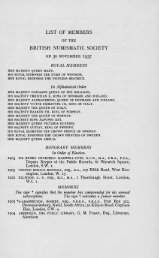

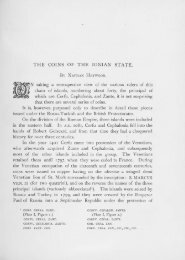
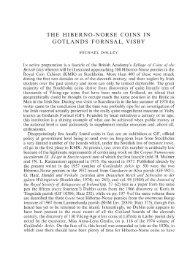
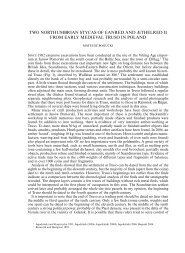

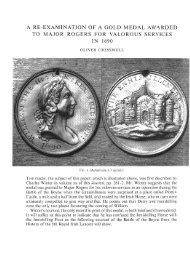
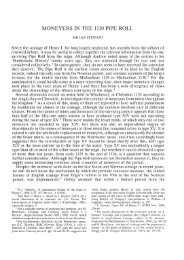
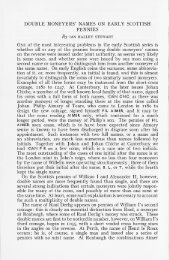
![Two Anglo-Saxon notes: [1] A Cnut die-link between the mints of ...](https://img.yumpu.com/15433998/1/189x260/two-anglo-saxon-notes-1-a-cnut-die-link-between-the-mints-of-.jpg?quality=85)
